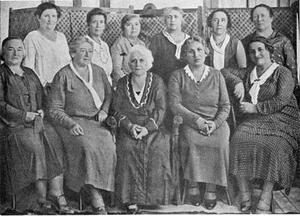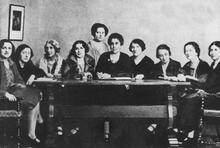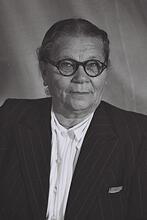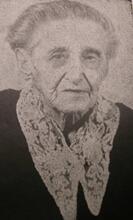Union of Hebrew Women for Equal Rights in Erez Israel
Courtesy of Ha-Keren le-Ezrat ha-Isha.
The Union of Hebrew Women for Equal Rights in Erez Israel was founded in 1919 by a nonpartisan group of Jewish women who saw women’s rights as fundamentally entwined with the Zionist vision. They advocated for women’s suffrage but also recognized that suffrage was only one aspect of the larger fight for full equal rights. The Union put forward a list of independent nonpartisan women candidates in the elections to the Constituent Assembly. This led to a fierce battle with the Orthodox parties, which the Union ultimately won; the National Assembly that gathered in 1926 declared that women would have equal rights, and the Orthodox circles withdrew their participation. Beyond suffrage, the Union also campaigned against child marriage and entered into international partnerships with other women’s rights organizations.
The Union of Hebrew Women for Equal Rights in The Land of IsraelErez Israel was established in the summer of 1919, initially in response to the opposition of Orthodox and some Mizrachi rabbis to women’s participation in the forthcoming elections for a voluntary body that would represent the entire Jewish population of Palestine. Prior to the founding of the Union, women’s activity had focused primarily on assisting women in the fields of health and social services through philanthropic organizations and frameworks of one kind or another. In 1920 the Histadrut Nashim Ivriot, the Hebrew Women's Organization, was the major force in the philanthropic field.
Women’s suffrage was not yet widely agreed upon in the new Jewish community in Palestine prior to the establishment of the State of Israel. "Old Yishuv" refers to the Jewish community prior to 1882; "New Yishuv" to that following 1882.Yishuv; indeed, it was still a novelty in many European countries. The Union, which led the fight for women’s suffrage until 1926, continued to work for full and equal political, legal, and economic rights for women until the establishment of the State in 1948, when it split and one part merged with the WIZO organization.
Founding of the Union
The founding members of the Union of Hebrew Women for Equal Rights in Erez Israel were Dr. Rosa Welt-Straus, Dr. Miriam Nofach, Esther Yevin, Hasya Sukenik-Feinsod, and Sara Azaryahu. The Union had eight branches: Jerusalem, Jaffa-Tel Aviv, Haifa, Rehovot, Rishon le-Zion, PetahTikvah, Safed, and Tiberias, each working individually in accordance with local needs. Each branch was active in introducing the right to vote in the voluntary committees of their communities. The first committee was founded in Rishon le-Zion, one of whose members was the author Nehama Pukhachewsky.The Jerusalem group served as the headquarters of all the branches and provided Hebrew classes, and hosted gatherings and lectures. Like many other organizations of the time, the Union had a central committee and a council, the latter (which met four times a year) being composed of representatives of the Union’s branches throughout the country.
The Union was structured on a non-partisan basis in order to enable women activists also to be members of other political parties. It reached out to women from every part of the political spectrum, perceiving women’s rights to be an inseparable aspect of the Zionist vision for a new society. In fact, the need to make women full participants in the Zionist Movement had been articulated and regulated by Theodor Herzl prior to the second Zionist congress in 1898. Union members who viewed women’s equality in society as a vital goal of their struggle waved the banner of the Zionist idea and vision, basing their demand for equality on the Zionist idea of building a national home for the Jewish people. In her first speech at the Union’s assembly before the community council elections, held in Haifa, Sara Azaryahu presented that national obligation in the following way:
We, the women of the latest wave of immigration, which has been going on for more than thirty years, since the Bilu group [first group arrived in Jaffa on July 6, 1882], did not come here as “ gentle creatures,” but as women of the nation who desire to fulfill the national duty that fate has imposed upon this generation (Azaryahu, 1957:158).
The Union’s oft-stated goal in its various decisions was to obtain equal rights for women because they were active members of society and equal human beings. Learning from the experience of women’s movements in other countries that the right to vote did not necessarily ensure full equality in economic and legal matters, the new organization, from its very onset, broadened its scope to promote full equal rights in all matters. Most of the Union’s members were educated Ashkenazi professionals, but the organization’s view of women as continuing to fulfill their traditional roles as wives and mothers while enjoying equal rights created a broad common basis that enabled women with widely differing views to become members.
Elections to the National Assembly
The Union made two vital decisions immediately upon its establishment. The first was to refer in the organization’s name to equal rights rather than to suffrage only, in order to indicate that the union’s final goal was “women’s equality in human society” (Azaryahu, 1977). The second decision was to create a list of independent, nonpartisan women candidates in the elections to the Constituent Assembly—an unusual move in the politics of women’s suffrage anywhere. The establishment of a women’s list for the elections was possible only because of the unique situation in the country: with no institution to form rules for the coming elections, women were able to participate in the elections for the National Assembly before its establishment and were granted the de facto right to vote before any decision in principle had been made in favor of women’s suffrage. Sara Azaryahu, who was aware of the importance of this unusual measure, called it “a one-of-a-kind maneuver so far unprecedented in women’s organizations in other countries” (Azaryahu, 1977). This situation allowed the Union to form an independent power base, to ensure representation for women, to influence the decision-making process in the Yishuv’s institutions, and to reach as many women as possible and encourage them to be active in public affairs. It also strengthened women’s status in other parties and ensured that parties would reserve places for women candidates on their lists. The Orthodox parties that participated in these elections were under the impression that women would not be elected and the National Assembly would not grant them tne vote. They were wrong.
The first elections took place in April 1920 and the first meeting of the National Assembly took place in October 1920. Among the nearly 320 delegates gathered in Jerusalem were 14 women. A fierce debate concerning women's right to vote broke out, and the Orthodox parties declared that unless women’s suffrage was abolished, they would not participate in the new national institution. The debate continued for over four years until the second elections, which took place in November 1925 without the participation of the Orthodox.The National Assembly that gathered in January 1926 declared without hesitation that women have equal rights. The fierce battle was won. The Orthodox circles did not participate in the National Assembly, the only organization that represented the Jewish people in Mandatory Palestine.
Additional Goals
Additional topics on the Union’s agenda included opposition to child marriage, women’s right to citizenship at the time of their immigration to the country and their right to obtain certificates for their families abroad on the basis of their own income, without their husbands’ permission (Ha-Isha, 1926). The British authorities in Palestine did not recognize women as an independent entity and based their refusal to prohibit child marriage on their policy of non-intervention with the religious customs of various communities. Child marriage was an accepted custom among the local Arab population and also among Old Yishuv Jews and Jews from Eastern countries.
The Union of Hebrew Women raised the latter subject for discussion before the Mandate committee in the League of Nations, which met in Geneva to discuss details of the Mandate for Palestine given to Great Britain by the League of Nations in April 1920 to administer Palestine and establish a national home for the Jewish people. It was terminated with the establishment of the State of Israel on May 14, 1948.British Mandate in Palestine (Azaryahu, 1929). Rosa Welt-Straus, to whom the problem of child marriage was of special importance, continued to raise the subject for discussion at the committee of the League of Nations. The members of the Union were also in contact with Rabbi Abraham Isaac Kook (1865–1935), negotiating with the chief rabbinate to try to convince it to change the situation (Union of Hebrew Women, 1925). Membership in international organizations enabled the Union members to make contact with women members of the British Parliament and request their involvement on behalf of women in Palestine. MP Eleanor Rathbone (1872–1946) even posed a question in the British Parliament on the subject of child marriage, but it took a long time and a determined struggle before the age of marriage was raised from thirteen to fifteen in 1936.
International Partnerships
The Union members, who were acquainted with international feminist activity, felt that membership in international organizations would enable them to broaden their power base. They themselves expressed solidarity with the women’s suffrage movement active throughout the world at the time, seeing the women’s movement in Palestine as “one link in a long chain of liberation movements among women the world over, half the human population” (Azaryahu, 1977). Similarly, the Union’s leadership realized that contact with organizations abroad would enable them to appeal to these groups for help when necessary and lend greater force to their demand for suffrage in the Jewish community (Jus Suffragii, 1920). Welt-Straus’s contacts with the International Woman Suffrage Alliance (IWSA) and the women who led it paved the way for the Union’s acceptance as a member in the IWSA. Its request to join the Alliance was initially discussed at a meeting of the Alliance’s leadership, at which the Union was accepted as a candidate for membership. It was granted full membership in 1923. Union representatives participated in four congresses of the IWSA held in Europe during the 1920s (Geneva, 1920; Rome, 1923; Paris, 1926 and Berlin, 1929). The Union’s acceptance into the IWSA in 1923 made it the first organization in the Jewish Yishuv in Palestine to win membership in any international organization.
Union members were similarly aware of their national mission to relate to Jewish society abroad, claiming that “the woman of the Yishuv is not fighting for herself alone, but for the rights of future Jewish women who immigrate to Palestine, and because of that, she sees no justification for concessions” (Azaryahu, 1977). The feeling of partnership in the national struggle and in the building of a new society was characteristic of the Union, as of other women’s organizations that were established at the time. Despite differences among these groups in world view and social perception, especially between the workers and the bourgeoisie, the ideological connection to Zionism was central to all of them.
Among the various Jewish women’s organizations that operated in the country during the Mandatory period, the Union of Hebrew Women was politically unique. Filled with faith in the Zionist ideal, which sought to build an egalitarian society in which Jewish women and men would live new lives, its members had every reason to believe that they would obtain equal rights and obligations in the new Zionist Yishuv in Palestine. This faith sustained them through many years of struggle, connected the women’s various constituent groups, and enabled them to ensure women’s participation in the political life of Jewish society in Palestine.
Azaryahu, Sarah. The Union of Hebrew Women for Equal Rights in Eretz Israel (Hebrew). Haifa: 1977 (reprint), English translation by Marcia Freedman, Haifa: 1980; (published first in 1949.
Azaryahu, Sara. Chapters of a Life (Hebrew). Tel Aviv: 1957.
Azaryahu, Sara. Report, 1929. Central Zionist Archive, J 875.
Berlowitz, Yaffa. Inventing a Country, Inventing a People (Hebrew). Tel Aviv: 1996.
Decisions of the Union Council. Central Zionist Archive, J35/14.
Ha-Isha 3 (1926), 32.
Jus Suffragii 15 (1920), 36.
Tahon, Rafi. The Struggle for Equality between the Sexes: The Story of Sarah Thon (Hebrew). Israel: 1996.
Committee meeting, Union of Hebrew Women, February 10, 1925. Central Zionist Archive,
J75/25.
Shilo, Margalit. Girls of Liberty: The Struggle for Suffrage in Mandatory Palestine. Waltham, MA: Brandeis University Press, 2016.











